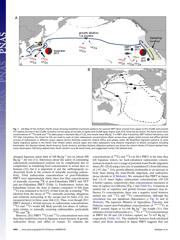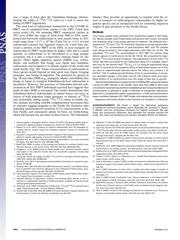Datasheet 搜索 > FPGA芯片 > Altera(阿尔特拉) > EP2C20F484C7N 数据手册 > EP2C20F484C7N 其他数据使用手册 4/4 页

 器件3D模型
器件3D模型¥ 2820.449
EP2C20F484C7N 其他数据使用手册 - Altera(阿尔特拉)
制造商:
Altera(阿尔特拉)
分类:
FPGA芯片
封装:
FBGA-484
Pictures:
3D模型
符号图
焊盘图
引脚图
产品图
EP2C20F484C7N数据手册
Page:
of 4 Go
若手册格式错乱,请下载阅览PDF原文件

over a range of dates after the Fukushima discharge (demon-
strating the utility of
134
Cs:
137
Cs ratios as a tool to assess the
timing of PBFT migrations).
The total load of radiocesium transported to the CCLME by
PBFT can be estimated from catches in the EPO. Catch data
varies yearly (10), but assuming PBFT commercial catches in
2011 were within the range of catch from 2000 to 2010, trans-
ported and harvested radiocesium in tuna muscle tissue in 2011
could range from ∼3–17 × 10
6
Bq (Table S4)or<<1% of total
radiocesium released into Japanese waters (4). Catch data rep-
resent a portion of the PBFT in the EPO, so total transport of
radiocesium by PBFT would likely be higher. Still, this is a small
quantity of radiocesium to be introduced to a large pelagic
ecosystem, but it is also a conservative estimate based on one
species. Other highly migratory species (HMS) (e.g., turtles,
sharks, and seabirds) that forage near Japan may assimilate
radiocesium and transport it to distant regions of the north and
south Pacific (Fig. 1B). Tissue concentrations of radiocesium in
these species would depend on time spent near Japan, foraging
strategies, and timing of migration. The potential for species in
Fig. 1B and other HMS (e.g., pinnipeds, whales, and billfish) that
forage in Japan to transport Fukushima-derived radiocesium is
speculative. However, the presence of Fukushima-derived radi-
ocesium in all 2011 PBFT individuals reported here suggests that
study of other HMS is warranted. Our results demonstrate that
Fukushima-derived radionuclides in animal tissues can serve as
tracers of both migration origin (presence or absence of
134
Cs)
and, potentially, timing (using
134
Cs:
137
Cs ratios) in mobile ma-
rine animals, providing valuable complementary movement data
to extensive tagging programs in the Pacific (8). Extensive data
regarding spatiotemporal variations in Cs concentrations in the
west Pacific, and consequent uptake by biota, are forthcoming,
which will sharpen the precision of these tracers. The Fukushima
disaster, thus, provides an opportunity to examine both the ex-
tent of transport of anthropogenic radionuclides by highly mi-
gratory species and an unexpected tool for examining migratory
origins of apex predators in the Pacific Ocean.
Methods
Tuna tissue samples were collected from recreational anglers in San Diego,
CA. Muscle samples were freeze-dried and ground with mortar and pestle
and analyzed using a low-energy germanium detector. We detected the γ
emissions of
137
Cs and
134
Cs,
40
K, and other naturally occurring radionuclides.
134
Cs and
137
Cs concentrations of post-Fukushima PBFT and YFT samples
were decay-corrected to the angler-estimated catch date for all fish. We
calculated
134
Cs and
137
Cs concentrations in 2011 PBFT for various times
before capture in California (0, 30, 60, 90, 120 d). We accounted for back-
ground
137
Cs in tuna muscle (1.0 Bq kg
−1
) by subtracting 1.0 from total
137
Cs
values. We then accounted for the radioactive decay of Cs isotopes, impor-
tant only for the shorter-lived
134
Cs (t
1/2
= 2.1 y) using an exponential decay
model. To account for the metabolic efflux of assimilat ed cesium out of fish,
we used an experimentally derived marine fish efflux rate constant k of
0.019 d
−1
(14). To address growth dilution of the Cs concentrations in muscle,
we calculated change in fish body mass (0–120 d before catch) and calcu-
lated dilution of Cs concentrations over this range of days due to growth.
We estimatedradiocesiumtransport to the CCLME by PBFTusingcatchdataas
a proxy for PBFT biomass in the CCLME. Catch data from 2000 to 2010 were
convertedtomusclebiomassandthenmultipliedbymeanmeasuredradiocesium
concentrations to generate a range of estimates of transported radiocesium.
Spearman’s ρ analyses (two-tailed, nonparametric; α = 0.05) were performed to
assess correlation between 2011 PBFT length and radionuclide concentrations.
Equations and further details of the methods are included in SI Methods.
ACKNOWLEDGMENTS. We thank S. Zegers for labo ratory assistance;
A. Carlisle for technical assistance; and K. Buesseler, M. Condrup, H. Dewar,
F. Micheli, and two anonymous reviewers for helpful comments. We also
thank the anonymous fishermen who donated fish samples toward this
study. This work was funded by the Gordon and Betty Moore Foundation.
1. Garnier-Laplace J, Beaugelin-Seiller K, Hinton TG (2011) Fukushima wildlife dose re-
construction signals ecological consequences. Environ Sci Technol 45:5077–5078.
2. Masson O, et al. (2011) Tracking of airborne radionuclides from the damaged Fu-
kushima Dai-ichi nuclear reactors by European networks. Environ Sci Technol 45:
7670–7677.
3. Buesseler K, Aoyama M, Fukasawa M (2011) Impacts of the Fukushima nuclear power
plants on marine radioactivity. Environ Sci Technol 45:9931–9935.
4. Buesseler KO, et al. (2012) Fukushima-derived radionuclides in the ocean and biota
off Japan. Proc Natl Acad Sci USA 109:5984–5988.
5. Bayliff WH (1994) A review of the biology and fisheries for northern bluefin tuna,
Thunnus thynnus, in the Pacific Ocean. FAO Fish Tech Pap 336(2):244–295.
6. Kitagawa T, et al. (2009) Immature Pacific bluefin tuna, Thunnus orientalis, utilizes
cold waters in the Subarctic Frontal Zone for trans-Pacific migration. Environ Biol
Fishes 84:193–196.
7. Young DR, Folsom TR, Hodge VF (1975)
137
Cs and
40
Kintheflesh of Pacific albacore,
1964-1974. Health Phys 29:689–694.
8. Block BA, et al. (2011) Tracking apex marine predator movements in a dynamic ocean.
Nature 475:86–90.
9. Schaefer KM, Fuller DW, Block BA (2007) Movements, behavior, and habitat utiliza-
tion of yellowfin tuna (Thunnus albacares) in the northeastern Pacific Ocean, ascer-
tained through archival tag data. Mar Biol 152:503–525.
10. Inter-American Tropical Tuna Commission (2010) Fishery Status Report (Inter-Ameri-
can Tropical Tuna Commission, La Jolla, CA).
11. Japanese Ministry of Agriculture, Forestry, and Fisheries (2011) Results of the in-
spection on radioactivity materials in fisheries products. Available at http://www.jfa.
maff.go.jp/e/inspection/index.html.
12. Aarkrog A, et al. (1997) A comparison of doses from
137
Cs and
210
Po in marine food: A
major international study. J Environ Radioact 34:69–90.
13. Stewart GM, Fowler SW, Fisher NS (2008) U-Th Series Nuclides in Aquatic Systems, eds
Krishnaswami S, Cochran JK (Elsevier, Amsterdam), pp 269–305.
14. Mathews T, Fisher NS (2009) Dominance of dietary intake of metals in marine elas-
mobranch and teleost fish. Sci Total Environ 407:5156–5161.
15. Aston S R, Stanners DA (1979) The determination of estuarine sedimentation rates by
134
Cs/
137
Cs and other artificial radionuclide profiles. Estuar Coast Mar Sci 9:529–541.
16. Smith JN, Ellis KM, Jones EP (1990) Cesium 137 transport into the Arctic Ocean
through Fram Strait. J Geophys Res 95:1693–1701.
17. Nagasawa K (1998) Predation by salmon sharks (Lamna ditropis) on Pacific salmon
(Oncorhynchus spp.) in the North Pacific Ocean. North Pac Anadr Fish Comm Bull 1:
419–433.
18. Shaffer SA, et al. (2006) Migratory shearwaters integrate oceanic resources across the
Pacific Ocean in an endless summer. Proc Natl Acad Sci USA 103:12799–12802.
19. Peckham SH, et al. (2007) Small-scale fisheries bycatch jeopardizes endangered Pacific
loggerhead turtles. PLoS ONE 2:e1041.
20. Farwell CJ (2011) Based on a Regression by C. Farwell (Tuna Research and Conser-
vation Center, Pacific Grove, CA).
21. Scida P, Rainosek A, Lowery T (2001) Length conversions for yellowfin tuna (Thunnus
albacares) caught in the western North Atlantic Ocean. Collect Vol Sci Pap ICCAT 52:
528–532.
22. Itoh T (2001) Estimation of total catch in weight and catch-at-age in number of
bluefin tuna Thunnus orientalis in the whole Pacific Ocean. Bull Natl Res Inst Far Seas
Fish 38:83–111.
23. Wild A (1986) Growth of yellowfin tuna, Thunnus albacares, in the Eastern Pacific
Ocean based on otolith increments. Inter-Am Trop Tuna Comm Bull 18:421–482.
24. Bayliff WH, Ishizuka Y, Deriso R (1991) Growth, movement, and attrition of northern
bluefin tuna, Thunnus thynnus, in the Pacific ocean, as determined by tagging. Inter-
Am Trop Tuna Comm Bull 20:3–94.
25. Wild A (1994) A review of the biology and fisheries for yellowfin tuna, Thunnus al-
bacares, in the Eastern Pacific Ocean. FAO Fish Tech Pap 336:52–107.
9486
|
www.pnas.org/cgi/doi/10.1073/pnas.1204859109 Madigan et al.
器件 Datasheet 文档搜索
AiEMA 数据库涵盖高达 72,405,303 个元件的数据手册,每天更新 5,000 多个 PDF 文件




